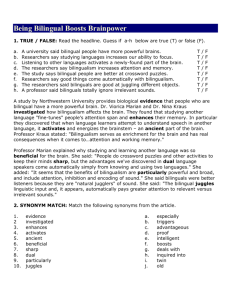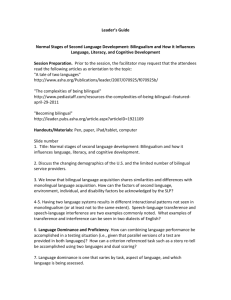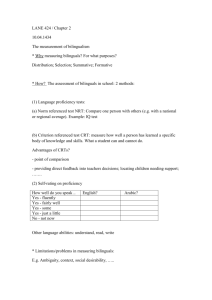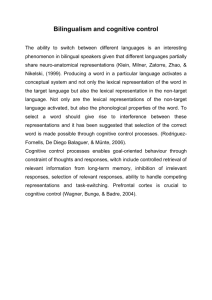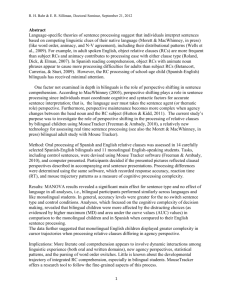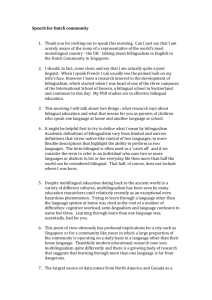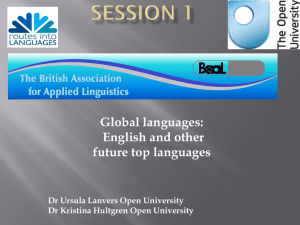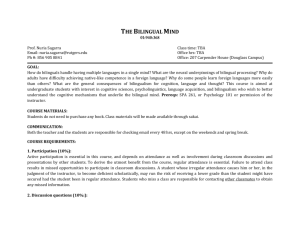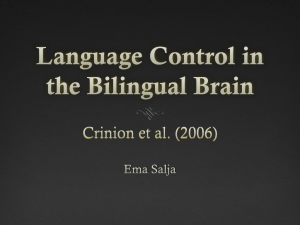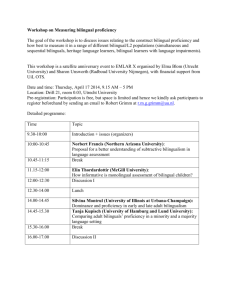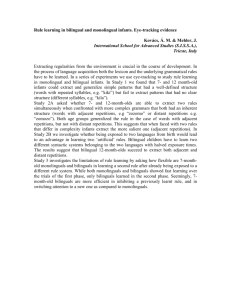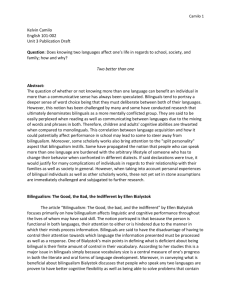Bilingualism - Signup4.net
advertisement
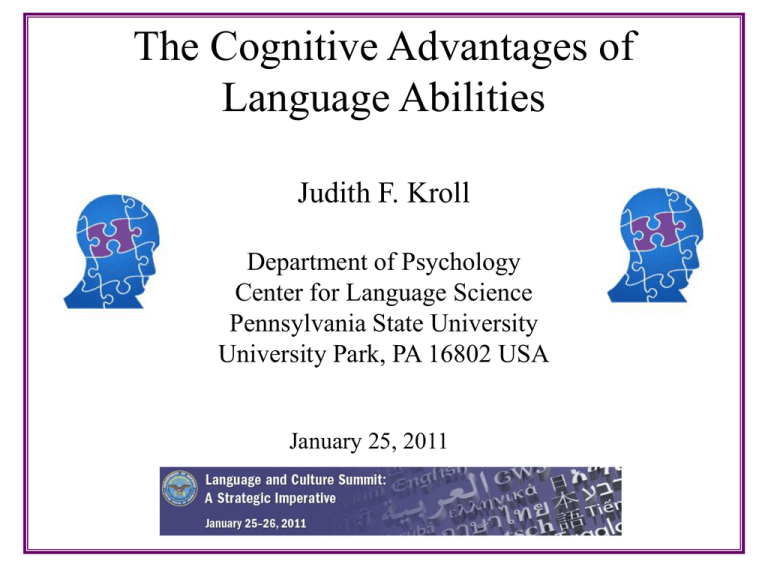
The Cognitive Advantages of Language Abilities Judith F. Kroll Department of Psychology Center for Language Science Pennsylvania State University University Park, PA 16802 USA January 25, 2011 More people in the world are bilingual than monolingual. But until very recently, most research on language and cognition examined only monolingual speakers of a single language and typically speakers of English as the native language. There are many reasons to learn a second language… Some of these reasons are more positive than self defense! Current research demonstrates that both of a bilingual’s languages are active regardless of the intention or requirement to use one language alone. The parallel activity of the two languages is hypothesized to produce competition. Skilled bilinguals rarely make the error of speaking the wrong language yet they often code switch with other similar bilinguals in the middle of a sentence, suggesting that they possess an exquisite mechanism of cognitive control. A life of resolving cross-language competition appears to confer positive consequences for cognition The bilingual is a mental juggler: Both languages appear to be active regardless of the requirement to use one language alone: Dutch-English speaker “bike” “fiets” Parallel activation in listening, reading, and speaking What is the consequence of parallel activity and competition across the bilingual’s two languages? The hypothesis is that mental juggling creates expertise. Bilingualism may confer specific cognitive benefits to executive function and attention to enable bilinguals to: ignore irrelevant information resolve conflict among competing alternatives minimize the costs associated with task switching To illustrate: Bilingualism may offer protection against the normal declines in attentional control associated with aging. Bialystok et al. (2005): Older bilinguals outperform agematched monolingual counterparts on the Simon Task and on other non-linguistic measures of inhibitory control. Bialystok et al. (2007): Bilingualism delays the onset of Alzheimers-type dementia by four years. Language experience may provide protection to the brain. The Simon Task Congruent Trials Incongruent Trials “Press the button on the left for Red and button on the right for Green” Bialystok et al. (2004): Magnitude of the Simon Effect by Decade: How much do individuals suffer the consequences of conflict? Hypothesis: The bilingual advantage arises from a life of resolving competition across the two languages. Does the brain reveal the consequences of using a second language? Mechelli et al. (2004): Learning an L2 increases the density of grey matter These benefits can be seen for young bilingual children, who seem better able to resist the allure of misleading information. To illustrate: Towers Task (Bialystok & Codd, 1997) Each block is one apartment; each apartment has one family Count the blocks in each tower Which apartment tower has more families living in it? Bilingual children are better than their monolingual counterparts at recognizing that the shorter tower has the larger number. And even for very young bilingual infants… Kovacs & Mehler (2009) compared bilingual and monolingual 7 month old infants on a switching task involving speech-like cues. Babies in a bilingual environment (crib bilinguals) were better able to switch their attention in response to a cue in watching a little puppet show than babies in a monolingual environment. How does the mental juggling of two languages create these advantages for cognition? The evidence to date is largely correlational. Bilinguals are advantaged relative to monolinguals on measures of attentional control and executive function. But what aspect of language use is responsible for these benefits to cognition? Hypothesis: Speaking! When you speak two languages you must choose between them before you utter a single word. Although babies do not speak so we might consider the baby bilingual advantages to suggest that there is more than one factor that benefits bilinguals. Methods to investigate language learning and language processing include behavioral measures, e.g., eye tracking and acoustic analyses of spoken language, and also neuroscience methods to examine brain activity. Research on producing speech in the L2 suggests that even highly proficient bilinguals must inhibit their stronger L1. That inhibition may impose a set of cognitive demands to allow proficient speech in the L2 without intrusions from the L1. Evidence on brain imaging shows that the areas of the brain associated with cognitive control are particularly active when bilinguals use their L2. Is there any context that makes this easier for someone learning a second language as an adult? Language immersion: Learners inhibit their L1 when in the L2 environment (e.g., Linck, Kroll, & Sunderman, 2009) On the 125th anniversary of the journal Science, Kennedy and Norman (2005) identified the biological basis of second language (L2) learning as one of the top 125 questions to be answered in the next 25 years of research: Second Language Acquisition Bilingualism 1200 1000 Number of Papers 800 600 400 200 0 1985-89 1990-94 1995-99 2000-04 2005-09 Time Period Research articles published on Second Language Acquisition and Bilingualism since 1985 (Web of Science) But we need more than language immersion for learners. We need research immersion to enable national and international research collaborations and to develop networks for training that will allow the next generation of researchers to become global scientists: Penn State University University Park, PA The Netherlands Spain Germany UK China Bilingualism takes different forms in different places The Penn State Center for Language Science Bilingualism Network Support from NSF PIRE (Partnerships for International Research and Education): 2010-2015: Bilingualism, mind, and brain: An interdisciplinary program in cognitive psychology, linguistics, and cognitive neuroscience Thank you!
